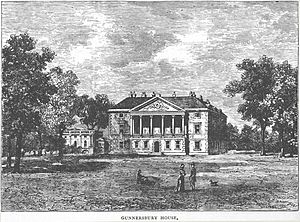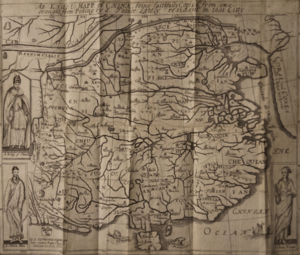John Webb (architect) facts for kids
Quick facts for kids
John Webb
|
|
|---|---|
| Born | 1611 |
| Died | 24 October 1672 Butleigh Court, Butleigh, Somerset
|
| Nationality | English |
| Occupation | Architect |
| Buildings | Wilton House |

John Webb (born 1611, died 1672) was an English architect and a smart scholar. He worked with another famous architect named Inigo Jones on some projects.
Contents
Life of an Architect
John Webb was born in London, England. He later passed away in Butleigh, Somerset. He worked very closely with Inigo Jones, who was also a famous architect and theatre designer. John Webb started as Inigo Jones' assistant in 1628.
In the 1640s and 1650s, Jones and Webb worked together. They designed Wilton House near Salisbury, England. This house is famous for its unique "Single Cube" and "Double Cube" rooms.
Webb's first known drawings were for the Barber Surgeons' Hall in London in 1636–37. He also designed a lodge in Hale, Hampshire, and stables for a Mr. Featherstone. It is not clear if these buildings were actually built.
During the English Civil War, Inigo Jones left London. John Webb stayed in London. He was appointed Deputy Surveyor by Jones. Webb secretly sent information to King Charles I of England. He sent plans of London's new defenses and the locations of new guns.
In 1649, Webb drew plans for Durham House in London. This was a project for a townhouse for the Earl of Pembroke. However, it was never built.
When Inigo Jones died in 1652, Webb received a lot of money. He also inherited Jones' large collection of drawings and designs. Many of these were from Jones' important trips to Italy.
Famous Buildings by Webb
In 1654, John Webb designed the first classical portico on an English country house. This was at The Vyne in Hampshire. A portico is a porch with columns. This design made the old house look like a Palladian building. This was 50 years before another famous architect, Lord Burlington, was even born.
In the early 1660s, King Charles II asked Webb to rebuild Greenwich Palace. The King wanted a more modern style. Webb planned three buildings around a courtyard. It would open towards the River Thames. The buildings were meant to line up with Inigo Jones' Queen's House.
The old palace buildings were taken down. But only one part of Webb's design was built. It was built between 1664 and 1669. The royal family never lived there. Later, it became part of Greenwich Hospital. It is now the eastern part of the King Charles Block. Webb also designed an expansion for the Queen's House in 1662.
Webb also helped with work at Kingston Lacy in Dorset. He supervised early building work around 1660. The designs for this stately home were originally made by Inigo Jones.
Webb also designed the rebuilding of Belvoir Castle in Leicestershire. This happened between 1654 and 1668. He also made changes to Northumberland House, a large London townhouse. He designed Gunnersbury House in Ealing too.
Webb's buildings often used a special stone finish called rustication. This made the stone look rough or textured. This was different from Inigo Jones' work, which used this style less often.
Webb's Legacy and Studies
More than 200 of John Webb's drawings still exist today. They are kept at Worcester College, Oxford, the Royal Institute of British Architects (RIBA), and Chatsworth House. Webb might have been planning to publish a book about classical building styles.
An unbuilt design for a theatre was found in the library of Worcester College. It is thought to be by Webb. This design was used to build the Sam Wanamaker Playhouse in London. It opened in 2014.
Webb's Writings
Webb worked with Inigo Jones and Walter Charleton on a book about Stonehenge. Ten years later, Webb published his own book. It was called Vindication of Stone-henge Restored.
Studying China
After the king was restored to power, people in England became very interested in China. Many books about China and its culture were published in the 1660s.
In 1669, Webb wrote a book called An historical essay endeavoring a probability that the language of the Empire of China is the primitive language. This was the first book in any European language to discuss the Chinese language. Webb had never visited China or learned the language. He based his book on stories from Jesuit missionaries who had traveled there.
Gallery of Architectural Works




